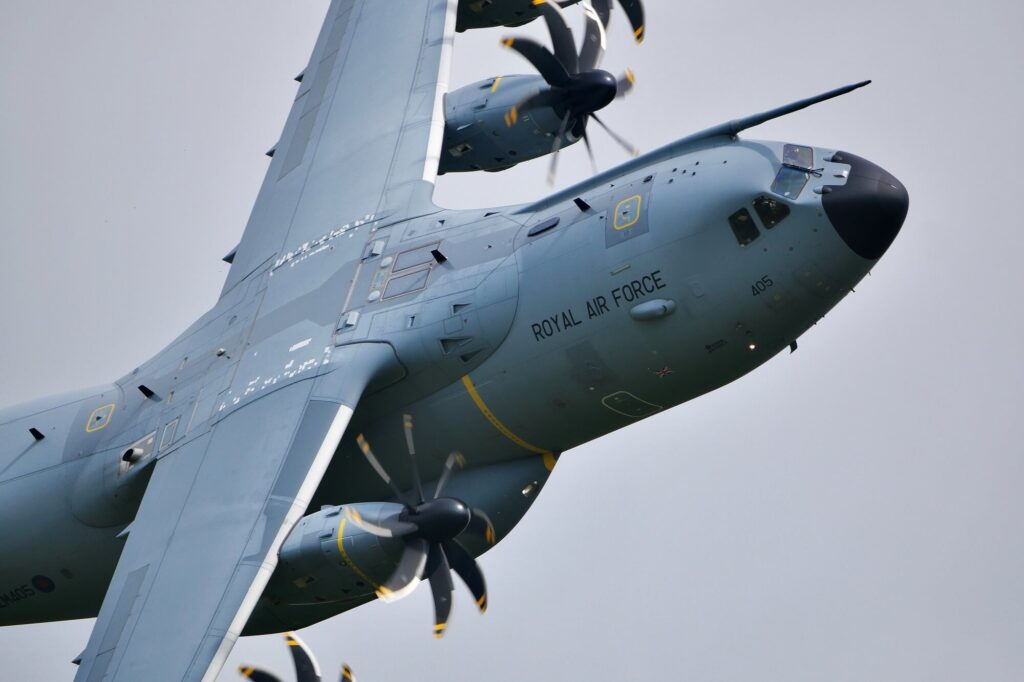On this day, nine years on from the first delivery to the French Air Force back in 2013, we look at 10 essential facts about the iconic Airbus Atlas A400M. In nearly a decade of operation, it has become a staple in air force fleets across Europe.
1. The origins of the Atlas A400M date back to 1982 when a joint venture between leading aerospace designers Lockheed, BAe and Aérospatiale and Messerschmitt-Bolkow-Blohm was formed with the goal of developing a replacement for the ageing C-130 and C-160 military transport aircraft.
Lockheed would eventually drop out in favor of developing the C-130J Super Hercules which is widely in service across the globe today. However, the European nations continued with their own development and, in 1999, Airbus Military delivered the Atlas C.1 A400M proposals.
2. Although now widespread within air force fleets including the RAF and the German Air Force, the Airbus Defence A400M program was nearly scrapped. Not only was the program years behind schedule and over budget, but reports suggested the aircraft was underdelivering on its performance and capabilities.
Nevertheless, the partner countries persevered and lent Airbus an additional €1.5 billion in funding to save the project. On December 11, 2009, the type took to the skies on its maiden flight before receiving its Certificate of Airworthiness from EASA in March 2013.
3. The A400M sits between the C130J Hercules and the larger Globemaster C-17 in terms of payload but is still as agile as the Hercules with takeoff and landing performance. It has a maximum range of 8,900 km, but with a higher payload of 30,000 kg it can fly up to 4,500 km.
The Maximum Takeoff Weight (MTOW) is 141,000 kg compared to 70,000 kg for the C130J Super Hercules and 265,352 kg for the C-17. With a payload of 37,000 kg, the A400M is capable of carrying 116 fully equipped troops or paratroopers.
4. While already capable of air-to-air refueling for fixed wing aircraft including fast jets, Airbus is hoping to gain certification for refueling of rotary wing helicopters in the near future following successful trial flights. This would be a significant selling point for Airbus.
5. Uncommonly for aircraft, the propellers are counter-rotating – the two propellers on each wing spin in opposite directions. The benefits, along with increased lift and fuel efficiency, is reduced torque, which in the event of an engine failure allows greater directional control as the asymmetric yaw tendency is eliminated.
As a result, the Airbus is more fuel efficient at low altitude than the C-17 but faster than the Hercules at higher altitudes and is capable of flying up to Mach 0.72.
6. The Royal Air Force routinely conducts takeoff and landings using the A400M on a beach in South Wales on essential training exercises. Incredibly for its size, the A440M’s tactical takeoff and landing distances are 980 meters and 770 meters respectively.
What an awesome sight Atlas A400M showcasing its capabilities by landing on a sunny beach in South Wales! and it was sunny @RAFBrizeNorton #A400 #Wales #avgeek #LandingStrip pic.twitter.com/Evhe96ViI7
— elwyn roberts (@elwynroberts1) September 18, 2020
7. The A400M has Automatic Low Level Flight capability. Initially approved for VMC (Visual Meteorological Conditions), the type achieved a new milestone in May 2021, completing certification flights for IMC (Instrumental Meteorological Conditions).
The A400M uses navigation and terrain databases to navigate terrain with the autopilot and auto throttle engaged down to an altitude of 500 feet, all without the pilots needing external visual references, a first for military transport aircraft.
8. In May 2020, in a show of the A400Ms capabilities, the French Air Force deployed two of its fleet from France to Tahiti, French Polynesia during the Covid-19 pandemic, carrying essential supplies and cash to the island nations.
The A400M also made its first appearance in New Zealand, picking up French Polynesian nationals who were stranded in the country following strict lockdown measures.
9. The A400M is currently in service with Germany, France, Spain, UK, Turkey, Belgium, Luxembourg and Malaysia. France and Germany with 50 and 53 orders respectively will have the largest fleets.
The role of the Atlas A400M varies from logistical to MEDEVAC and repatriation. The hold can be transformed into a hospital ward with up to 66 stretchers and 25 medical personnel. The aircraft is also fitted with chaff and flare to counter missile attacks adding to its survivability on vulnerable missions.
10. To date, the A400M has amassed 178 orders, of which 105 have been delivered. In late 2021 and in a boost to the Airbus Defence Program, the Republic of Kazakhstan and the Indonesian military each ordered two A400m, with the latter having options for a further four aircraft.

